Art History: Chapter 6 - Early Indigenous Art of the Americas
1/52
There's no tags or description
Looks like no tags are added yet.
Name | Mastery | Learn | Test | Matching | Spaced |
|---|
No study sessions yet.
53 Terms
Background
Prehistoric people used North Atlantic, Bering Land, and Australia-South America route to get to the Americas
Ice caps caused people to be cut off from other regions
Artwork is referred to as Pre-Columbian
Clovis Period (16000 - 8000 BC)
North America was last continent to be inhabited by people
Had nomadic lifestyle with hunter gatherers
Animals were extinct besides camels
Ice melting created the Great Plains
Archaic Period: Projectile points, stone & pottery artifacts
Woodland Period: Increased settlements and agriculture
Archaic Period (8000 - 3000 BC)

Deer/Bighorn Sheep
Visual
Made of willow twigs
Depicts animals such as deer and bighorn sheep
Iconographic
Made during the Archaic Period
Found in Arizona
Is the earliest art in North America
Purpose unknown but most likely used in hunting rituals or as children’s toys

Petroglyphs
Visual
Made of sandstone
Are rock paintings depicting large geometric shapes, animals, and humanoid figures
Iconographic
Made during the Archaic Period
Found in Nevada
Were carved into sandstone with a harder rock
Woodland Period (3000 BC - 1000 AD)
In the east/midwest
Had lots of mound building
Mound building used as platforms for temples
Could also be burial mounds
Sometimes part of massive earthworks
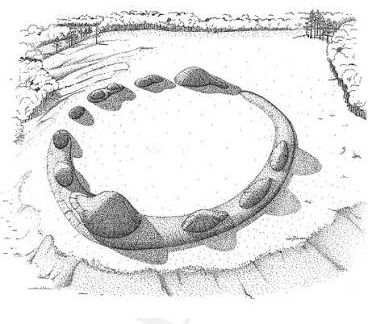
Watson Brake
Visual
Made with earth and clay
A village that was a circular site with mounds
Largest mound is 25 ft tall
Iconographic
Made in the Woodland Period
Found in Louisiana
Most likely built before the Great Pyramids of Egypt
No public access to the mounds
Projectile points, fire-earthed blocks, and other artifacts were found
Unknown why all the mounds were made
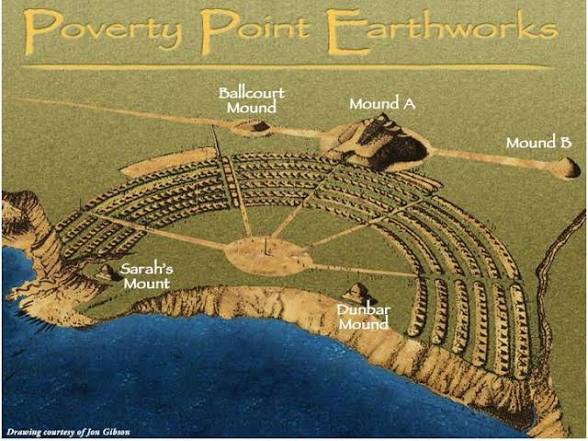
Poverty Point
Visual
Semicircular plot with a large mound at the top & a ball court
Mound A is 72 ft tall
1.3 km wide and used 238500 cubic meters of soil to build
Iconographic
Made in Woodland Period
Found in Louisiana
Mound A took thousands of people 30-90 days to build
No evidence of erosion or vegetation shows it took little time to build
Some form of leadership needed to organize the mound building
Mound A was most likely used as a temple
Arrowheads, ceramic vessels, and adornments (beads & gorgets) were found
Gorgets had incised lines and were worn at the throat
Beads were in animal shapes (birds and pigs)
People here were first in Louisiana to use pottery
Most clays weren’t mixed with anything, but some had plant fibers to stop cracking from firing
Marking the pot when it was hard gave it artistic appeal
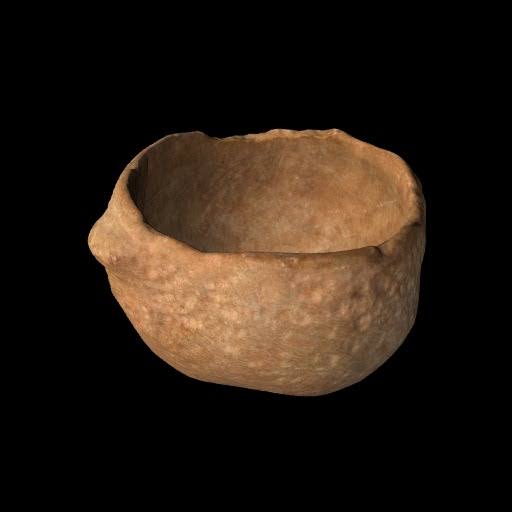
Soapstone Bowls
Visual
Made of quarry stone
Simple, naturalistic
Low intensity hue of brown
Iconographic
Made in Woodland Period
Found at Poverty Point in Louisiana
Were sent out for trade after being hardened
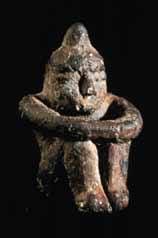
Clay Figures
Visual
Made of clay
Depicts women in different varieties; some without hair, some without heads, some pregnant
Iconographic
Made in Woodland Period
Found at Poverty Point in Louisiana
Unknown significance
Possibly symbols of fertility, used as children’s toys, or depicts ancestors
Hopewell Culture (100 BC - 500 AD)
Part of the Woodland Period
Mordecai C. Hopewell: A farm owner who owned the land where significant earthworks were excavated in 1891
Resting place was only for leaders
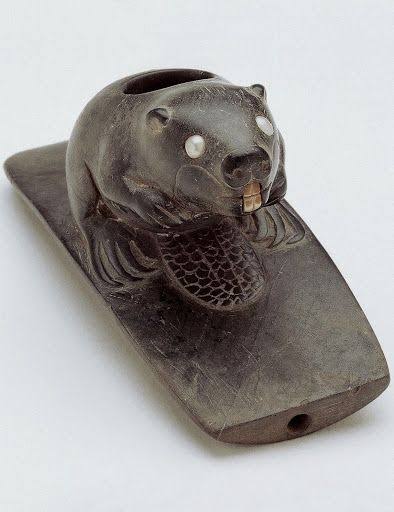
Beaver Effigy Platform Pipe
Visual
Made of pipestone, river pearls, and bone
Beaver is naturalistic
Bone is teeth and pearls are eyes
Beaver’s on a platform with a hole on top
Iconographic
Part of the Hopewell Culture
The pearls have a spiritual association
Hole at the top is to put tobacco in
Animals represented clans/families

Vessels
Visual
Made of pipestone
Depicts birds of all varieties
Are naturalistic and idealistic
Iconographic
Part of the Hopewell Culture
Used for storage, cooking, and holding offerings for burial purposes
Birds linked the human world with the sky (world of spirits and deities
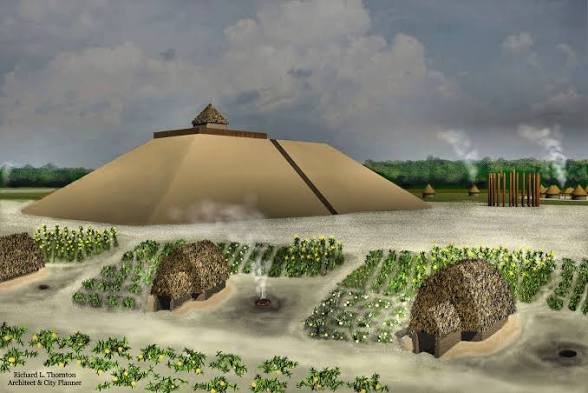
Kolomoki Mounds
Visual
Made of earth
57 ft tall temple mound
Two small burial mounds
Several ceremonial mounds
Iconographic
Part of the Hopewell Culture
Is the largest/oldest woodland nature American Site
Inside, leaders were surrounded with sacrificed family and servants
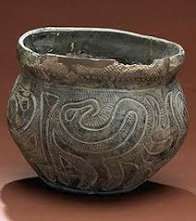
Burial Mound Pottery
Visual
Made of clay & grid tempered limestone
Depicts unknown male, ducks/birds with cutoffs
Iconographic
Part of the Hopewell Culture
Unknown significance, but most likely used for ceremonial purposes
Hohokam Culture (50 - 1450 AD)
Part of Woodland Period
“Those who have vanished”
One of the earliest agriculture societies
Developed irrigation & canal networks, had ball courts, & pottery connected with Mesoamerica
Had scarlet macaus, stone balls, mosaics, etc.
In pre-classic period, red ware ceramics & irrigation increased
In classic period, ceramics and cremation increased
Motifs and symbols starts as civilization evolves
Markets were made
In later classic period, markets & ball courts decline
Salado religion is embraced
Redware Pottery: Earliest of Hohokam artworks
Red on Buff Pottery: Later artworks with motifs
Mesoamerica
Consists of Tlatico, Olmec, Colima, and Zapotec
Earliest civilizations developed close to the equator for warmth (agriculture)
Lots of geology/habitats
Jade was the equivalent to gold due to polish and color
Yax: Blue-green jade that was most preferred
Tlatico Period (1250 - 800 BC)
“Place of hidden things”
Nearby lake was an important food source
Had maize domesticated and people settled in villages
Over 3000 burials that contained small ceramic figures
Animal vessels were replicated in ceramics
No record for why these were made
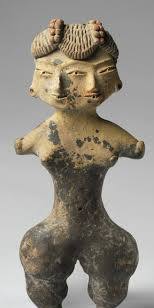
Tlatico Figurines
Visual
Made of clay
Are bifurcated, with either two faces/heads but 3 eyes or two heads and one body
Hair & nose incised with sharp instruments
Some depicted scenes of daily life
Iconographic
Made in Tlatilco Period
Found in burials
More intimate than earlier Mesopotamian art due to scenes depicted
No written record for why these were made
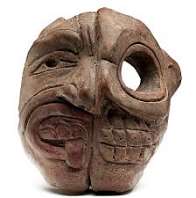
Duality Mask
Visual
Made of ceramic clay
Has both alive and skeletal (dead) side
Animal side looks animal-like with its tongue out
Is small enough to fit in hand
Iconographic
Made in Tlatilco Period
Found in burials
Duality in Mexico could be cycle of life and death or regeneration
No written record for why these were made
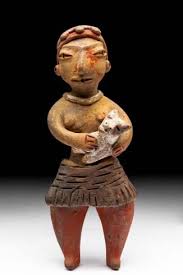
Female with Dog
Visual
Made of clay
Depicts a woman holding a dog
Woman has traces of black, yellow, and red pigment
Dog is painted with white pigment
Incised lines helped shape features
Iconographic
Made in Tlatilco Period
Unknown significance
Most likely a Tlatilco figure that depicts a scene of daily life

Tlatico Bowl
Visual
Made of ceramic and blackware clay
Shade of black
Iconographic
Made in Tlatilco Period
Were special bowls made for burials
Olmec Empire (1500 BC - 400 AD)
Earliest of Mesoamerican civilizations
Built the first cities in Mesoamerica along the Gulf Coast
Success due to freshwater and fertile soil
Used slash and burn farming
Had a diet of veggies, fish, birds, possums, deer, and dogs (for protein)
Oldest Western civilization to use calendars, compasses, and a written language
Lots of ball courts with 9-pound balls
Used trade networks to obtain rate materials like obsidian due to durability
Population started to decline around 400 BC
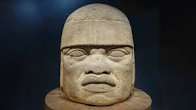
Colossal Heads
Visual
Made of basalt
Depicts males with close fitted caps, chin straps, and carpools that pierce the ear
Realism as it depicts different people & caps
Ranged in height (4-12 feet)
Iconographic
Made in Olmec Empire
Could represent leaders, priests, or ball players
Early religious rites
Were transported into cities
17 have been found; 10 in San Lorenzo and 4 in La Venta
Some were mutilated and burned
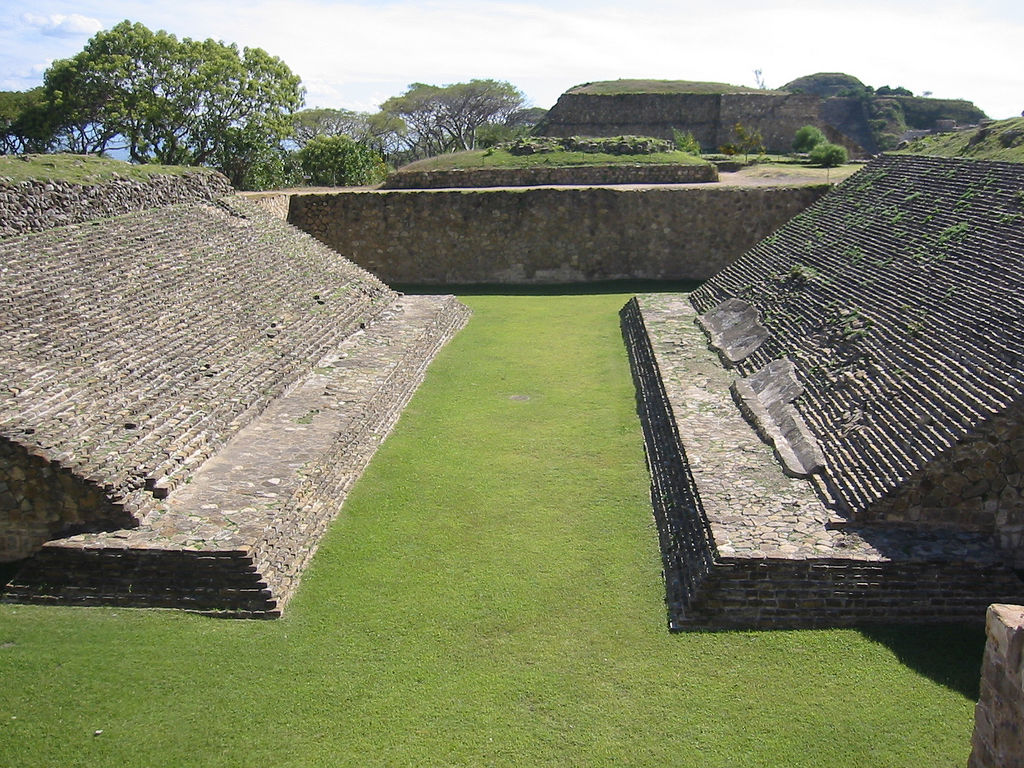
Ballcourts
Visual
Made of stone
Flattened to earth and parallel rectangles with stones on top
Iconographic
Made in Olmec Empire
Oldest known court in a sacred city precinct
Strong associated with warriors and war captives
Players were betted on and winners got trophies
Some trophies found in graves (possible link to the afterlife but not likely)

Great Pyramid + Plaza
Visual
Made of earth
Has large ceremonial center built at the top and stone-carving workshops
Iconographic
Made in Olmec Empire
Found in La Venta
Took double the labor of Poverty Point
People gathered to see things happening at the center
Artificial sacred mounds aligned with the cosmos (linked to cosmology)
Not tombs, but had artifacts buried underneath
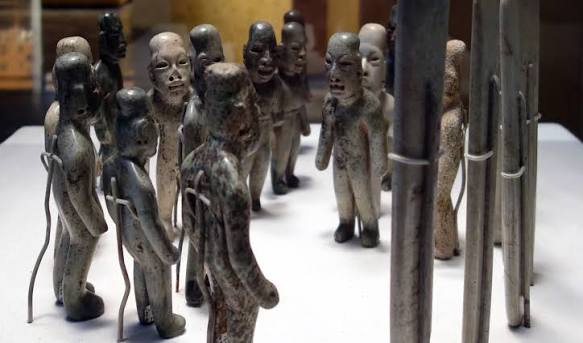
Offering 4
Visual
Made of jade, greenstone, granite, and sandstone
Depicts nude, slouched bodies with elongated heads and holes in ears
Has marking on the celts
Cleaned in pure white sand
Iconographic
Made in Olmec Empire
Found below the Great Pyramid arranged on a sandy floor
Greenstone symbolizes fertility
Markings on celts are difficult to understand
Were covered in put in cinnabar pigment (red/orange) and hematite
Pure white sand symbolizes that this was a high value offering
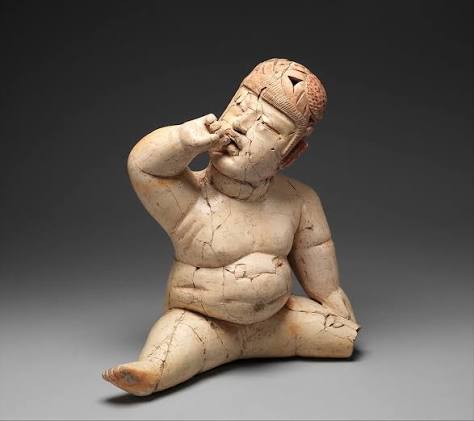
Babies
Visual
Made of ceramic with white cayline clay
Depicts life-sized (10-14 ft tall), hollow, pudgy, expressive babies
Are nude but has no genitals (androgynous)
Has oversized heads with helmet-like headdresses
Iconographic
Made in Olmec Empire
Were made from 1200 - 900 BC
Some show duality, signifying that these may show regeneration symbolism
Oversized heads depict artificial cranial deformation, a practice that shaped the head in a certain way at a young age
Unknown where these came from and why the practice of making them stopped
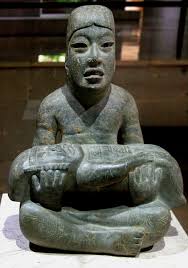
Lord of Las Limas
Visual
Made of greenstone
Depicts baby in the hands of a man
Baby and man have multiple inscriptions and patterns
Iconographic
Made in Olmec Empire
Were found by kids
Baby is a rain deity with were-jaguar facial features
Mythological connection of infants & fertility of agriculture
Adult could possibly be a shaman, a spiritual healer who’s an intermediary between the human and spirit world
Function of sculpture unknown, but may have been a portable object for rituals

Kunz Axe
Visual
Made of jade
An 11 inch carved figure
Very large head in high relief (over 50% of the figure)
Humanlike almond eyes and flat nose
“Jaguar-shaped” mouth with holes on the side
Body is in shallow relief & is simplified compared to the stylized head
Most likely had clothes at one point
Two hands gripping unknown object
Iconographic
Made in Olmec Empire
Never used as an axe
A votive used for ritualistic purposes in honoring the gods
Large, high relief head symbolizes the importance of the head in Olmec culture
No metal tools for drilling, so abrasion was used
An overall symbol of an Olmec god that’s possibly were-jaguar
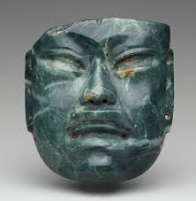
Olmec Mask
Visual
Made of jadeite (transparent jade)
Incisions of cleft marks
Naturalistic and idealistic
Iconographic
Made in Olmec Empire
Not an actual mask because there’s no holes for the eyes or mouth
Cleft marks symbolize that this is an Olmec Maize God
Represents the earth from which maize sprouts and grows
Colima Period (300 BC - 300 AD)
Thrived in the west & south (mostly in West Mexico)
Has artifacts dating back to 12000
Artifacts found in underground chambers with numbers figurines, vessels, etc surrounding leaders
Ceramics are naturalistic animals & men
Women were barely depicted

Dog
Visual
Made of pottery & red slip clay
Depicts hairless dog with round body and perky ears in a short-squat position
Iconographic
Made in Colima Period
Represents dogs that were eaten at feasts to assist the dead in the journey to the afterlife
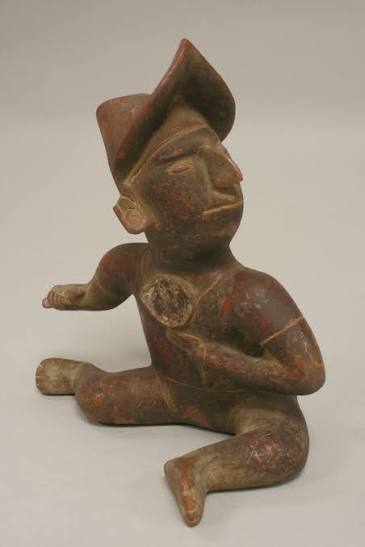
Warrior
Visual
Made of pottery
Naturalistic and animated with a geometric body
Has a special hat and pendant around its neck
Iconographic
Made in Colima Period
Representation of a warrior
Likely served a ceremonial for funerary purposes

Horned Figure
Visual
Made of pottery and red-brown slip clay
Depicts seated male figure with strapped, stylized horns, stubby arms and legs
One hand is in a closed fist
Iconographic
Made in Colima Period
Horns probably a symbol of leadership
Most likely represents a shaman who’s a guardian/protector in the afterlife
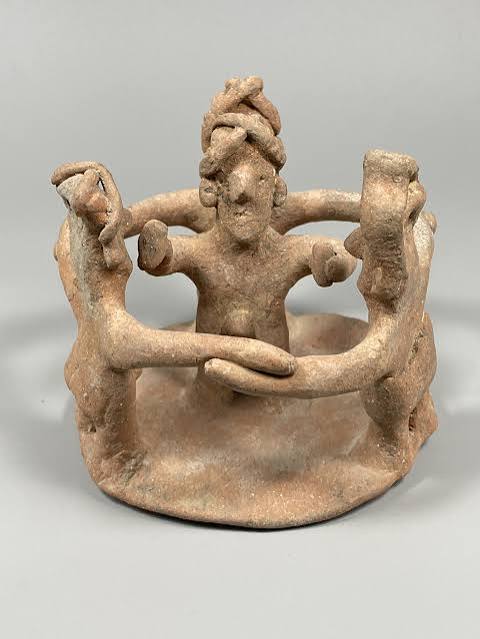
Ring of Figurines
Visual
Made of solid clay
Depicts 3 men extending arms around a central figure
Central figure’s holding an unknown object
Figures are abstract and exaggerated with long arms and coffee bean eyes
Iconographic
Made in Colima Period
Figures were pinched into their shapes
Has an unknown meaning and function
Zapotec Period (700 BC - 1521 AD)
Oaxaca highlands are where the Zapotec thrives
Ditched the nomadic lifestyle & settled in villages
Monte Alban known for pyramid platform plazas, stone monuments, residential terraces, ball courts, defensive walls, and network of roads
Rulers controlled the hundreds of villages & towns and were laid to rest in an alter that had around 170 royal tombs
Mitla (Iyova) known as “place of the dead” due to Zapotec and Aztec bloody war
Mitla was an important religious center for Oaxaca Valley people
Zapotec writing system hasn’t been fully unencrypted
Had unique structures, pottery, sculptures, and irrigation canals
Knowledge of their daily life & religious beliefs come from Spanish conquistadors and priests (later Zapotec society)
Zapotec split into classes of nobility and commoners
Nobles were allowed feather garments, jade earplugs, and eating deer meet
Commoners, especially successful merchants, could amass more wealth than nobles
Nobles acted as religious heads with men undergoing religious trainings
Zapotec religion was animistic, with a Supreme Being that people couldn’t pray or interact with
People could pray to other supernatural forms of nature like lightning, clouds, rain, etc.
Deities often represented in the forms of animals like jaguars and bats
Bats were extremely important to the Zapotec

Ancestor Figure
Visual
Made of pottery with brown clay
Is a naturalistic and idealistic artwork
Has a mask and glyphs/early writing
Iconographic
Made in Zapotec Period
Unknown if these are ancestors or deities
Could be figural pots, offering vessels, or funerary urns
Unknown what was contained in these
Mask had potent supernatural forces
Glyphs could depict a day in the Zapotec calendar
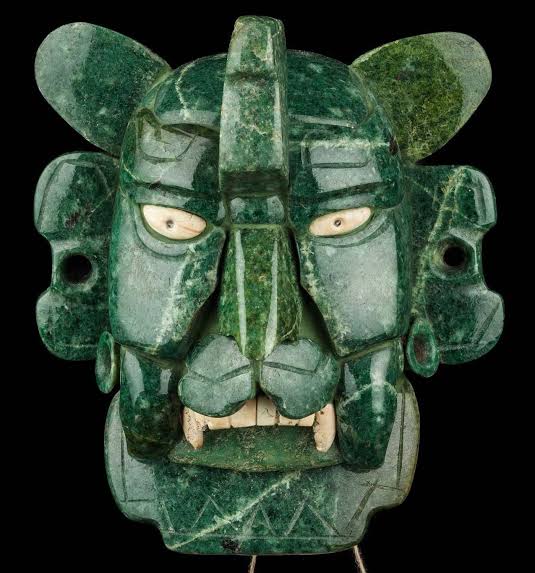
Zapotec Mask
Visual
Made of jade
High intensity hue of green
An idealistic and styilzed mask
Most likely depicts a vampire bat
Iconographic
Made in Zapotec Period
Found in Oaxaca
Has unknown use
Bat deities were related to the sacred world for the dead/underworld
Nightfall was the world for spirits and death
Vampire bats feed on the blood of mammals, which is associated with rites of bloodletting and sacrifices
South America: Peru
Consists of Cupisnique, Salinar, Paracas, and Nasca
Complex societies developed
Sandwiched between east and west coast
Has monumental architecture and textiles that’s around 3500 years old
Cupisnique Culture (1500 - 500 BC)
The mother culture (Culvin evolved from them)
Evidence of early Pre-Columbian culture
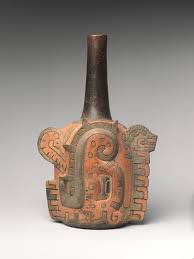
Feline Head Bottle
Visual
Made of ceramic and pot-fired paint
Depicts several faces in generalized animal styles
Feline face on right side
Left side is tongue/tail and eye/ear depending on how you’re looking at it
Pendant iris, which is hanging from the top of the eye, is a black pupil
Iconographic
Part of Cupisnique Culture
Was used to pour things
Was painted before fired, signaling its delicacy
Used for ritualistic purposes
Could symbolize shamanic vision of peaceful spirit animals as the rules
If you could read it, you belonged in the group
Salinar Culture (200 BC - 300 AD)
Existed on south coast of Peru
Has lots of spider imagery
Spider’s ability to catch & kill live prey were linked to warfare and ritual sacrifice
Spiders also represented agricultural fertility and rain
Had vessels of animals & people that ranged in colors of orange to brown

Nose Ornament with Spiders
Visual
Made of gold
A semicircular ornament of geometric shapes with spiders in each of them
Iconographic
Part of Salinar Culture
Done with the repousse method
Repousse Method: Hammering gold into a metal sheet to shape its appearance
Hung from the septum of the nose
Is lightweight like a cobweb
Were fashionable among high-level men, signaling a shift in personality
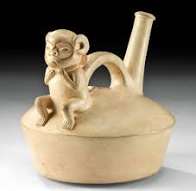
Vessel of Monkey
Visual
Made of ceramic
Naturalistic
Iconographic
Part of Salinar Culture
Accurate details means the person has seen real monkeys
Monkeys were kept as pets
Unsure of any vessels’ significance
Paracas Culture (600 BC - 200 AD)
In South Mexico
Early textiles and fabrics were made with fibers by weavers
Weavers used both old & new techniques
Cotton and camelid fibers came from alpacas and llamas
Textiles were popular in wrapping deceased bodies, sometimes having multiple wrapped in one body (as much as 2000)
Fabrics retained its complexity and color despite being centuries old
Embroidery used cotton and camelid fibers for decorative messages
More complex textiles and fabrics were more expensive
All unknown reasoning for art

Border Fragment
Visual
Made of cotton and camelid fiber
High intensity hues of red, yellow, green, and blue
Depicts two naturalistic & abstract figures with arched backs that switch positions, depicting motion
Iconographic
Part of Paracas Culture
Represents skeletonized figures
Unsure what they’re doing (maybe flying?)
Would be brought over the shoulders to wear

Mantle with Double Fish Pattern
Visual
Made of cotton and camelid fiber
Depicts lots of “fish”
Shows composite view of “fish” as eyes are shown frontally and from above
Also (maybe) shows family patterns with baby fish
Iconographic
Part of Paracas Culture
Made using the block-color style
Block-Color Style: Stitches outline shapes then fill them in with color, creating a linear style
Pairs of animals are probably sharks and not fish due to gills behind the eyes
Probably symbolizes mythological transformation from shark to human due to arms projecting from fish body
Most likely worn by men
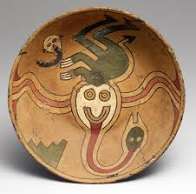
Flying Figure Bowl
Visual
Made of ceramic and pot-fired paint
Depicts supernatural Paracan figure, an abstract pompous cat, and black sloth-looking animal
Supernatural Paracan figure has serpent head with fangs coming out
Has curvelinear lines of red and orange
Green steps
Iconographic
Part of Paracas Culture
Not a daily bowl & was probably used for ritual purposes
Paracan figure is an ovulate due to overly large eyes
Paracan figure represents the Burrowing Owl
Pompous cat is a common motif of a guardian being inside the cat
Cats were possibly also kept as pets
Sloth-looking figure depicts power and fertility
Nasca Culture (1 - 800 AD)
Neighbored the Paracan people
Shared their love for textiles and multicolored pottery
Pottery was mostly animals or vessels in their shapes
Pottery had more color variations than other Pre-Columbian cultures
Agriculture was life
Known for massive geoglyphs/earth drawings consisting of animals

Earth Drawings
Visual
Made of earthy material
Depicts several symmetrical animals
Massive, single-lined artworks
Iconographic
Part of Nasca Culture
Drawn with no tools but hands
Discovered in 1939 by a pilot flying over the geoglyphs
Used for people to dance along the lines and pray to appease the Gods enough to bring rain

Nasca Pottery (Drum)
Visual
Made of ceramic
Depicts fat-bodied figure shaped into the instrument, with the legs curved into the round body
Has a snake under the chin
Has profiled killer whales around the eyes
Has headband with horn-like projection
Hair is serpents with long tongue
Iconographic
Part of Nasca Culture
Was a sounding chamber
Figure was upside down when played
Used in ceremonies, most likely for religious significance (probably for rain)
Horned-like projection most likely shows leadership

Mantle
Visual
Made of cotton and camelid fiber
Depicts many humans and animals, with some in duplicates and some by themselves
Some are holding severed heads
Has leaves and feathers attached to border
Iconographic
Part of Nasca Culture
Used cross-looping to help efficiently weave
Used warp-wrapping to make geometric faces
Severed heads have mythological meaning, with sacrifices giving way to fertility
Illegally exported in 1931-1933